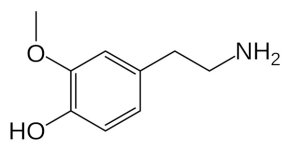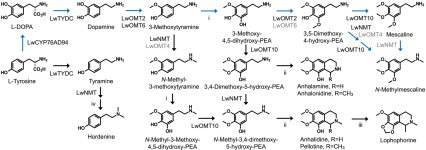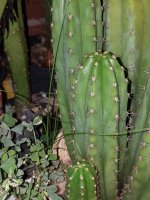[:]
Established member
A study from the late 80s found that small amounts of N-methyltyramine were found in the brains of mice after administration, though 80% of the NMT was excreted rapidly. I posit that the addition of the methyl group to the molecule likely increases its ability to pass the blood brain barrier and I suspect that this is also true for the alkaloid 3-methoxytyramine. 3-methoxytyramine is also known to occur in the active San Pedro cactus species as 1-10% of the total alkaloid content.
These tyramine variations are known as agonists at the trace amine receptor TAAR1, which appears to be involved strongly in the effects of stimulants like amphetamines.
I suspect that the stimulant effects noted from species like Trichocereus pasacana are due to the methylated tyramines and I expect that they can alter and affect cactus experiences when co-administered with mescaline.
It is my contention that there is a plausible basis for suspecting that San Pedro cacti do contain psychoactive alkaloids other than mescaline and that those alkaloids appear to be stimulant, rather than psychedelic in action. As that up to 10% of the alkaloids of the San Pedro cacti have been reported to be 3-methoxytyramine, I expect that as the dose and or potency increases the action of these alkaloids becomes more relevant to the experience in a dose dependent manner.
I also suspect that reports of cacti being able to be used like San Pedro, but different in terms of effects, relate to cacti whose primary alkaloids are methylated tyramines, such as N-methyltyramine, and that the effects are stimulant in nature, rather than psychedelic.
In a related topic, the enzyme pathways of hybrid cacti potentially contain contributions from both parents, ergo a cactus that produces mescaline, crossed with a cactus that produces hordenine (N-dimethylated tyramine) should potentially produce offspring that contain N-dimethylated-mescaline aka Trichocereine. That topic is worthy of another thread, one about enzymatic pathways and products in terms of hybrids of San Pedro cacti and their allies.
Suffice it to say, I expect that reports of certain cacti having different feels to them are not merely a matter of mescaline dose variation, but also relate to the ingestion of 3-methoxytyramine. This is in contrast to the often repeated mythology that flavonoid molecules and inhibition of MAO are responsible for the reported differences. At this point I speculate based on the chemistry and pharmacology, however this hypothesis is able to be tested by trialing combinations of mescaline, purified via chromatography, with varying amounts of 3-methoxytyramine, as well as through the experimental ingestion of 3-methoxytyramine by itself.
These tyramine variations are known as agonists at the trace amine receptor TAAR1, which appears to be involved strongly in the effects of stimulants like amphetamines.
I suspect that the stimulant effects noted from species like Trichocereus pasacana are due to the methylated tyramines and I expect that they can alter and affect cactus experiences when co-administered with mescaline.
It is my contention that there is a plausible basis for suspecting that San Pedro cacti do contain psychoactive alkaloids other than mescaline and that those alkaloids appear to be stimulant, rather than psychedelic in action. As that up to 10% of the alkaloids of the San Pedro cacti have been reported to be 3-methoxytyramine, I expect that as the dose and or potency increases the action of these alkaloids becomes more relevant to the experience in a dose dependent manner.
I also suspect that reports of cacti being able to be used like San Pedro, but different in terms of effects, relate to cacti whose primary alkaloids are methylated tyramines, such as N-methyltyramine, and that the effects are stimulant in nature, rather than psychedelic.
In a related topic, the enzyme pathways of hybrid cacti potentially contain contributions from both parents, ergo a cactus that produces mescaline, crossed with a cactus that produces hordenine (N-dimethylated tyramine) should potentially produce offspring that contain N-dimethylated-mescaline aka Trichocereine. That topic is worthy of another thread, one about enzymatic pathways and products in terms of hybrids of San Pedro cacti and their allies.
Suffice it to say, I expect that reports of certain cacti having different feels to them are not merely a matter of mescaline dose variation, but also relate to the ingestion of 3-methoxytyramine. This is in contrast to the often repeated mythology that flavonoid molecules and inhibition of MAO are responsible for the reported differences. At this point I speculate based on the chemistry and pharmacology, however this hypothesis is able to be tested by trialing combinations of mescaline, purified via chromatography, with varying amounts of 3-methoxytyramine, as well as through the experimental ingestion of 3-methoxytyramine by itself.






